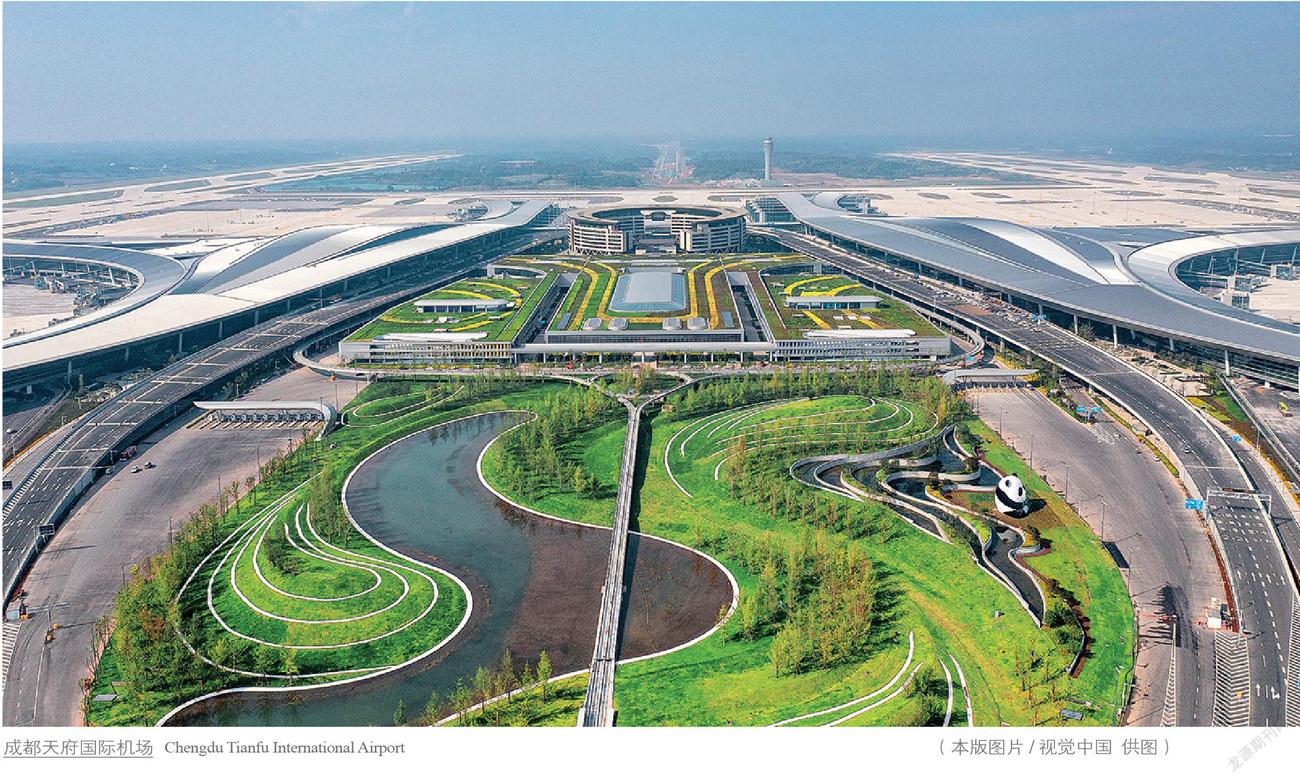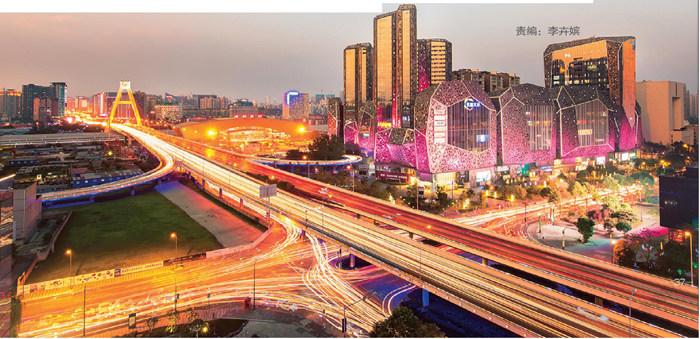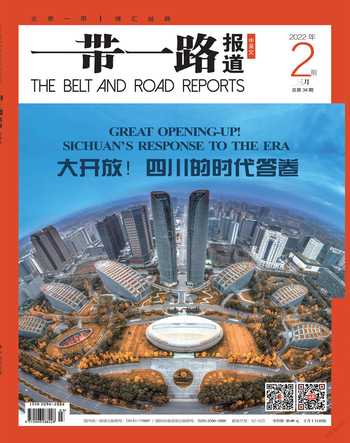纵横通衢联世界
贾琪




1月10日11时10分,车身涂装鲜亮国槐绿的D843次“复兴号”动车组沿新成昆铁路,以时速160公里一路向南,从西昌西站驶往昆明。这是四川省凉山彝族自治州开行的首趟复兴号动车组,至此结束了四川大凉山不通动车的历史。
复兴号开进大凉山,是四川交通腾飞的一个缩影。千古百业兴,先行在交通。“十四五”时期,四川交通科学谋划,由“蜀道通”向“蜀道畅”跨越、由交通大省向交通强省跨越、由西部综合交通枢纽向国际门户枢纽跨越,书写交通强省建设的新篇章。
动车开进大凉山
说起四川大凉山,就会想起“横断山,路难行,天如火来水似银”;就会想起深山与老林,跋山与涉水;就会想起站站停靠的“慢火车”。进入新世纪,随着高铁动车在全国普及,“动车开进大凉山”成为当地百姓的梦想。
如今,复兴号终于开行,西昌到攀枝花的铁路时间从3个多小时缩短到1小时43分钟,西昌到昆明从7个小时缩短至4个小时,一步跃千年的凉山州正式迈入“动车时代”。
从此山不再高,水不再远,动车能让更多人走进这片神奇的土地。越西文昌故里、彝海纪念馆、西昌卫星发射中心等旅游资源不再“待字闺中”,德昌的水果、西昌的板鸭等丰富的物产资源也将乘坐风驰电掣的复兴号去到千家万户。
成昆铁路公司西昌指挥部指挥长邹永木介绍,成昆铁路复线在四川省境内分为成都至峨眉、峨眉至米易、米易至攀枝花三段建设。目前,仅剩峨眉至冕宁段正在加紧建设。全线建成通车后,将北接宝成铁路、成渝铁路,南连贵昆铁路,直接到达广西沿海,与东南亚铁路接轨,成为重要的出川铁路大通道。
目前,凉山州不仅有复兴号带动沿线百姓快速出川,还保留着一对时速三四十公里的公益性慢火车。“复兴号”与“慢火车”,一快一慢之间,见证着四川铁路发展的世纪变迁。
“十四五”期间,四川还将规划建设高速铁路1300公里,城际铁路550公里,普速铁路1940公里。到2025年,铁路进出川通道达12条、新增1条,高铁全省覆盖13个市(州)。
与此同时,沿着复兴号的行驶轨迹,在一排排铁轨之外,我们还可以看到:从前山脊荒凉,如今遍布风电机组,陡峭山腰嵌起银色玉带,那是一条条连接乡镇与城市的畅通公路。
2021年,广安绕城高速公路、内江城市过境高速公路、四川宜宾至云南彝良高速公路(四川段)……相继开通,全省高速公路通车里程突破8600公里,稳居全国第三位。
预计到2025年,高速公路出川通道达37条、新增13条,覆盖全省152个县(市、区)。按照《四川省“十四五”综合交通运输发展规划》,公路建设不仅打通“最后一公里”,还将实现由“通不通”向“优不优”的质的飞跃。
从高处俯瞰,一条条通村公路在山野中蜿蜒,一栋栋居民新楼掩映于花前、树下、塘边,沿途村落美景串珠成线,“交通+产业”“交通+旅游”等融合发展模式助力乡村振兴,看得见、摸得着的致富大道正从各个村落延伸铺展开来,带领老百姓奔向更加幸福美好的未来。
“神鸟”联通世界
“玉带”绕青山,天堑变坦途。不管是“地下”,还是“天上”,四川交通发展一路高歌猛进。
1月19日,飞常准APP发布的《2021年度全球民航航班运行报告》显示,在中国内地千万级机场中,成都双流国际机场出港航班量位居第二,成都天府国际机场是中国内地航班准点率最高的机场。
时间回到2021年6月27日,成都天府国际机场正式投运。在凭借“国际一流、国内领先”的建设理念刷屏的同时,其与成都市中心50公里的距离,让不少人尤其是凌晨落地的乘客心头一紧。
为提高乘客来往天府国际机场的舒适性和便捷性,成都地铁、出租车和机场大巴等多力并發,构建起“零距离换乘”的高效综合交通系统:
每日夜间在机场等候的巡游出租车不低于70台。地铁18号线快线单程只需39分钟。机场大巴有两条线路滚动发车。成都市交通运输局轨道处相关负责人介绍,正在建设中的地铁19号线也将连通中心城区和天府国际机场,而预计分别将于2023年底和2025年建成投运的成自高铁、成达万高铁也将与机场形成接驳。
在最大程度解决机场接驳问题的同时,天府国际机场与双流国际机场实现“两场一体”运营,天府国际机场重点打造国际客货运航空枢纽,双流国际机场主要运营国内商务、地区航线,两个机场互为备降机场,逐步形成错位发展、功能互补、协同联动的双枢纽机场体系。
四川不靠海、不沿边,长期以来面临内陆地区该如何与世界对话的问题。实践证明,从交通入手,航空是最佳突破口。
1984年,成都航空口岸开埠,当年出入境流量仅2万人次。随着国际航线网络不断拓展和口岸服务水平不断提升,发展至今,成都航空口岸成为中国第四个出入境人员流量突破700万的一类航空口岸。随着天府国际机场投运,北京、上海、广州、成都4个国家级国际航空枢纽在中国版图上空勾勒出一条面向欧亚大陆的“U”形空中廊道,成为“一带一路”倡议最佳的空中回响。
如今,成都已开通国际(地区)客货运航线131条,其中定期直飞航线81条,国际航线开行总数稳居全国第四、中西部第一。
“十四五”期间,四川还将新增乐山机场、广安机场、遂宁机场、会东机场、甘洛机场5个机场,预计到2025年,四川民用运输机场建成及在建数达22个,共同建设中国民用航空第四极,合力打造世界级机场群。
除了“神鸟”联通世界,中欧班列、铁水联运等西部陆海新通道多线并发,亦是衔接“一带一路”的重要途径。
中欧班列(成都)自2013年开行以来,保持良好发展态势,截至2021年11月25日,年开行量超2000列,连接67个境外城市站点。目前,全省稳定运行泸州至成都、昆明、攀枝花等11条铁水联运班列,并结合海运和中欧班列,形成四川“通疆达海”大循环大通道。
城際“画圈成网”
交通日新月异的快速发展,四通八达的路网在拉近四川与世界距离的同时,也加速了省内城际间的融合,使得自家人“串门儿”更为方便。
2021年12月10日,G0511线德阳至都江堰高速公路开通运行。至此,成德眉资同城化的交通基础设施标志性工程──成都都市圈环线高速公路(又称“成都三绕”)全线通车。
建设好成都都市圈不仅要畅通道路的“硬连接”,还要打通服务同城化的“软连接”。《成都都市圈发展规划》提出,要提升铁路公交化运营水平,促进轨道交通、跨市公交、城市公交有机衔接,构建多种运输方式无缝换乘的公共交通服务体系。
围绕这一目标,2021年10月26日,成都天府通APP扫码乘车在眉山正式上线运行。眉山市民安装天府通APP,就可在成德眉资4市所有城区内运营公交车辆的IC卡刷卡机上享受“扫码通乘”。目前,成德眉资4市均已实现一码通乘,且共享9折优惠。
一码玩转4市,何其快哉!
随着都市圈的融合发展,跨城通勤也日趋常态,为满足城市内越来越多“候鸟”群体的通勤需求。2021年,成德眉资4市还推进动车公交化运营,实现都市圈日开行动车119对,日均客流约2.4万人次。
而另一边的成渝地区双城经济圈的交通发展也如火如荼。
2020年底,成渝客专就已完成提速改造,最高运行时速从300公里提升至350公里,全程历时从1.5小时缩短至62分钟,两地实现“1小时通达”。同时,成渝两地还推进铁路公交化运营。两地平均发车间隔10分钟,最小发车间隔5分钟;高铁及动车日均开行达110对,日均往来客流约6万人次。
自成渝地区双城经济圈建设提出以来,轨道上的双城经济圈正在加快构建——铁路方面,成达万高铁、成自高铁、成渝铁路扩能改造正加快建设;水运方面,联手建成长江上游首个万吨级码头——新生港;联运方面,合力建设西部陆海新通道,推动成都国际铁路港与重庆国际物流枢纽园、万州港开展多式联运合作……
当下,按照“外建大通道、内建大网络、共建大枢纽”的发展思路,一个外畅内达、便捷高效的现代交通圈正在巴蜀大地上加快形成,并画圈成网。
At 11:10 on January 10, “Fuxing” bullet train D843, with its body painted in bright green, headed southward along the new Chengdu-Kunming Railway from Xichangxi Railway Station to Kunming at a speed of 160km per hour. This was the first “Fuxing” bullet train launched in Liangshan Yi Autonomous Prefecture, Sichuan Province, marking the end of the time without bullet trains in the region of Daliang Mountains in the province.
“Fuxing” bullet train entering the area of Daliang Mountains is a microcosm of Sichuan’s rapid development in transportation. “Transportation creates prosperity in all sectors”. During the “14th Five-Year Plan” period, Sichuan will scientifically plan its transportation construction. It aims to build an unimpeded transportation network and grow from a major province to a strong province in transportation and from the comprehensive transportation hub in western China to an international hub and gateway, writing a new chapter in the construction of a strong province in transportation.
Bullet train enters the area of Daliang Mountains
Speaking of Daliang Mountains in Sichuan, we may think of the lyrics “In Hengduan Mountains, roads are bumpy, the sky is as red as fire, and the water is like silver” or an arduous journey in deep mountains and thick forests or trains that ran slowly and stopped frequently. With the popularity of high-speed and bullet trains across the country in the new century, the local people dreamed that “bullet trains could enter the area of Daliang Mountains” one day.
As the “Fuxing” bullet train was finally open to traffic, the time from Xichang to Panzhihua is shortened from more than 3 hours to 1 hour and 43 minutes (fastest) and the time from Xichang to Kunming from 7 hours to 4 hours, enabling Liangshan Prefecture to officially enter the “era of bullet trains”.
Since that day, the once remote, mysterious land of Daliang Mountains has been within reach of people from outside. Thus, local tourism resources—such as the Hometown of Wenchang, Yihai Alliance Memorial Hall, and Xichang Satellite Launch Center—are known and visited by a lot more people, and rich natural resources like Dechang’s fruits and Xichang’s salted ducks are delivered to customers nationwide via “Fuxing” bullet trains.
Zou Yongmu, commander of the Xichang headquarters of Chengdu-Kunming Railway Co., Ltd., introduced that the double line of Chengdu-Kunming Railway in Sichuan Province is divided into three sections in construction: Chengdu–Emei, Emei–Miyi, and Miyi–Panzhihua. At present, only the section from Emei to Mianning is under accelerated construction. When the whole line is completed and open to traffic, it will link Baoji-Chengdu Railway and Chengdu-Chongqing Railway in the north and Guiyang-Kunming Railway in the south, directly reach the coast of Guangxi, and connect with Southeast Asian railways, becoming a major channel for Sichuan to reach to the outside world.
To date, Liangshan Prefecture has not only had “Fuxing” bullet trains to bring people along the line a fast mobility experience in going out of Sichuan, but has also kept a pair of nonprofit slow trains—with a speed of 30km to 40km per hour. The fast “Fuxing” bullet train and the “slow train” comparatively demonstrate the century-long development of Sichuan’s railways.
During the “14th Five-Year Plan” period, Sichuan also plans to build 1,300km of high-speed railways, 550km of intercity railways, and 1,940km of normal-speed railways. By 2025, there will be 12 entry and exit railway passages in Sichuan, including a newly constructed one, with 13 cities (prefectures) within the province covered by high-speed railways.
At the same time, along the tracks of “Fuxing” bullet trains, we can see that those once desolate ridges are now covered with wind turbine generators, and steep hillsides are embedded with silver “jade belts”, which are motorways connecting villages and towns with cities.
In 2021, multiple expressways including Ring Expressway of Guang’an, Ring Expressway of Neijiang, and Yibin-Yiliang Expressway (Sichuan section) were open to traffic successively, bringing the province’s expressway mileage to a threshold of over 8,600km, ranking third across the country.
It is expected that by 2025, Sichuan will own 37 exit expressways, including 13 newly constructed ones, covering 152 counties (cities and districts) in the province. According to the Comprehensive Transportation Development Planning under the 14th Five-Year Plan of Sichuan Province, highway construction in the province will not only get through the “last kilometer”, but also achieve a great leap from being “unimpeded” to “excellent”.
Viewed from above, all highways leading to villages wind in dense forest-covered mountains, and newly-built residences stand along the highways, interspersed with trees, flowers, and pools, looking like pearls on strings. Integrated development models such as “transport + industry” and “transport + tourism” drive rural revitalization, with tangible roads toward prosperity extending to all villages, leading the locals to a happier and better future.
“Solar divine bird” links Chengdu to the world
“‘Jade belts’ twist around green mountains; natural moats change into highways”. Whether underground or in the sky, Sichuan’s transportation has made great headway in an all-around way.
Among airports on the Chinese mainland with a cumulative passenger throughput of 10 million or more in a calendar year, Chengdu Shuangliu International Airport ranked second in departures, and Chengdu Tianfu International Airport boasts the best on-time flight performance in the country, according to the 2021 Global Civil Aviation Flight Operation Report released by VariFlight app on January 19.
Back on June 27, 2021, Chengdu Tianfu International Airport was officially put into operation. With a construction concept of “being among the first class internationally and the leading one domestically”, the airport once went viral on the internet. However, the long distance of 50km from the airport to downtown Chengdu was truly a great concern for passengers, especially for those who would land during the wee hours.
To improve the comfort and convenience for passengers, subways, taxis, and airport shuttle buses in Chengdu have made concerted efforts to build an efficient comprehensive transportation system that realizes “zero-distance transfer”.
While solving the problem of the airport’s connection to the downtown area to the greatest extent, Chengdu Tianfu International Airport and Chengdu Shuangliu International Airport have achieved the “two-as-one” combined operation: The former focuses on developing into an aerial port for the transportation of both passengers and goods, and the latter mainly operates the domestic business and regional routes; the two airports both act as the alternate for each other. In that way, a dual airport hub system with dislocation development, complementary functions, and coordinated operation gradually forms.
Neither near the sea nor the nation’s border, Sichuan, an inland area, had long faced the problem of how to communicate with the outside world. Practice has proved that it is best to start from transportation, especially aviation.
In 1984, Chengdu opened its first airport, with only 20,000 entry and exit passengers through the port within a year. However, with the continuous expansion of the international airline network and improvement of port service level, Chengdu’s airport became the fourth first-class airport in China with the number of entry-exit passengers breaking through the mark of 7 million. After Chengdu Tianfu International Airport opened, the four national international-level aviation hubs—Beijing, Shanghai, Guangzhou, and Chengdu—together outline a U-shaped air corridor facing the Eurasian continent over China’s territory, echoing the national Belt and Road Initiative.
Up to now, Chengdu has opened 131 international (regional) passenger and freight transportation routes, including 81 regular direct routes. Its total number of international routes ranks fourth in China and first in central and western China.
During the “14th Five-Year Plan” period, Sichuan will build five additional airports, namely Leshan Airport, Guang’an Airport, Suining Airport, Huidong Airport, and Ganluo Airport. It is estimated that by 2025, Sichuan will have 22 civil transport airports completed or under construction, with the aim of building the fourth pole of China’s civil aviation and creating a world-class airport cluster.
Besides the “solar divine bird”, new international land-sea trade corridors in the west— such as the China Railway Express (CR Express) and rail-water combined transport—were opened, which also facilitate the implementation of the Belt and Road Initiative.
Among them, the CR Express (Chengdu) has maintained a good momentum of development since its start of operation in 2013. By November 25, 2021, the number of its annual departures and arrivals had exceeded 2,000, with the trains connecting 67 overseas cities. Currently, Sichuan Province has been operating 11 trains for railway-sea combined transportation that run from Luzhou to Chengdu, Kunming, Panzhihua, and other cities respectively, and has also combined sea transportation and CR Express to establish a major cyclic channel connecting Sichuan to the outside in all directions.
Intercity network
Not only has the increasingly improved transportation network drawn Sichuan much closer to the outside world, but it has also sped up intercity integration within the province, making it easier for people in different places of Sichuan to visit each other.
On December 10, 2021, the G0511 expressway from Deyang to Dujiangyan was put into operation. Since then, Chengdu’s metropolitan loop expressway (also known as “Chengdu’s third belt freeway”)—a landmark transportation infrastructure project for the integration of Chengdu, Deyang, Meishan, and Ziyang—has been fully open to traffic.
In addition to unimpeded roads, building a Chengdu metropolitan area also requires city integration-related services. The Development Plan for Chengdu Metropolitan Area proposes to improve the operational level of railways as routine public transport, link rail transit, intercity public transport, and urban public transport, and build a public transport service system that allows seamless transfers among various modes of transport.
To this end, the service of scanning a QR code and taking a public vehicle went live on the Tianfu Tong app in Meishan on October 26, 2021. Residents in Meishan who installed the app can enjoy the service via the IC card scanners on all public vehicles operating within the urban areas of Chengdu, Deyang, Meishan, and Ziyang. At present, it has been realized in all of the four cities to take all public vehicles across them with one QR code, and a 10% discount is available,
Great convenience and tangible benefits have been provided to people traveling between the cities.
With the integrated development of metropolitan areas, cross-city commuting is becoming increasingly normal. To meet the daily needs of a growing number of long-distance commuters, the four cities initiated the operation of bullet trains as routine public vehicles in 2021, achieving the operation of 119 pairs of bullet trains in metropolitan areas every day, with an average daily number of passengers up to 24,000.
On the other hand, the transportation construction for the Chengdu-Chongqing economic circle is in full swing.
By the end of 2020, the upgrading and transformation for Chengdu-Chongqing passenger transport lines were completed, with their maximum speed increased from 300km to 350km per hour, shortening the time taken for traveling between Chengdu and Chongqing from 1.5 hours to 62 minutes and realizing “one-hour trip” between the two cities. In the meantime, the two cities promoted the operation of the railway as routine public transport. The passenger transport trains between two cities depart at intervals of 10 minutes on average, with the shortest interval of five minutes; an average of 110 pairs of high-speed rail and bullet trains operate daily, with an average daily number of passengers reaching some 60,000.
Since the construction of the Chengdu-Chongqing economic circle was put forward, the building of its related rail infrastructure has been expedited. In terms of railways, the expansion and renovation of Chengdu-Nanchong-Dazhou-Wanzhou High-speed Railway, Chengdu-Zigong-Yibin High-speed Railway, and Chengdu-Chongqing Railway are speeding up. In terms of water transport, Chongqing Xinsheng Port, the first 10,000-ton port on the upper reaches of the Yangtze River, has been jointly completed. In terms of combined transport, concerted efforts have been made to build the New International Land-Sea Trade Corridor (ILSTC), in a bid to accelerate the cooperation of Chengdu International Railway Port with Chongqing International Logistics Hub Park and Wanzhou Port in multi-modal transport ...
Currently, by adhering to the development concept of “Building a big channel outside, a big network inside, and a big hub together”, a wide range of convenient and efficient modern traffic circles is taking shape on the land of Sichuan, together forming a large network.
链接Link:
四川“十四五”交通规划
2021年10月26 日,四川省人民政府印发《四川省“十四五”综合交通运输发展规划》,提出到2025年,初步建成“四向八廊”战略性综合交通走廊和成渝地区双城经济圈国际性综合交通枢纽集群,基本形成“123出行圈”和“123快货物流圈”,基本实现“快速网覆盖区(县)、干线网畅达乡镇、基础网连接村组”,为打造全国交通“第四极”奠定坚实基础。
“123出行圈”指成都都市圈1小时通勤、成渝地区双城经济圈2小时通达、全國主要城市3小时覆盖;“123快货物流圈”指国内1天送达、周边国家2天送达、全球主要城市3天送达;覆盖区县的“快速网”由高速铁路、高速公路、民用运输机场构建;畅达乡镇的“干线网”由普速铁路、普通国省道、内河高等级航道、市域铁路组成;连接村组的“基础网”由农村公路、通用机场织就。
“十四五”时期,综合交通建设完成投资1.2万亿元以上,其中公路水路7000亿元、铁路3000亿元、民航250亿元、轨道交通2200亿元。
Transportation planning of Sichuan Province during the “14th Five-Year Plan” period
On October 26, 2021, the People’s Government of Sichuan Province issued the Comprehensive Transportation Development Planning under the 14th Five-Year Plan. According to it, by 2025, Sichuan will preliminarily build the “four-way and eight-corridor” strategic comprehensive transportation pattern and an international integrated transportation hub cluster of Chengdu-Chongqing economic circle. Besides, the province will basically form the “1-2-3 travel range” and “1-2-3 logistics range” and manage to construct “a fast transportation network covering all districts (counties), a trunk network reaching all villages and towns, and a basic network connecting all village groups”, thus laying a solid foundation for creating the “fourth pole” of national transportation.
The “1-2-3 travel range” refers to one hour of commuting within Chengdu’s metropolitan areas, two hours of traveling within the Chengdu-Chongqing economic circle, and three hours of reaching any major city in China; the “1-2-3 logistics range” refers to one-day goods delivery within China, two-day delivery in neighboring countries, and three-day delivery to major cities around the world. The “fast transportation network” will consist of high-speed railways, expressways, and civil transport airports; the “trunk network” will be composed of normal-speed railways, ordinary national and provincial highways, high-grade inland waterways, and municipal railways; the “basic network” will be woven with rural highways and utility airports.
Also, during the period, Sichuan will invest more than 1.2 trillion yuan in comprehensive transportation development, including 700 billion yuan for highways and waterways, 300 billion yuan for railways, 25 billion yuan for civil airports, and 220 billion yuan for rail transit.

